Utah Highway Patrol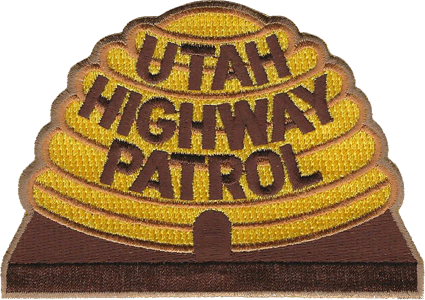
Utah Highway Patrol
In 1923, The Utah State Legislature empowered the State Road Commission to patrol the highways of the State. The highways were patrolled on a part-time basis by two state employees, designated as "patrolmen."
The organization was known as the "State Road Police Patrol". In 1928, Three additional full-time patrolmen were hired. Uniforms and badges, were issued. The first uniform was forest green with a patch of a flying motorcycle wheel sewn on the left arm and on the hat. Smith & Wesson .44 caliber revolvers, with cross-draw holsters, were issued to patrolmen.
In 1933, the organization is redesignated as the "Utah Highway Patrol." The ranks of superintendent, captain, lieutenant, and sergeant are established. The first driver license law becomes effective and the UHP is given responsibility for testing applicants, and the UHP has 30 sworn officers as of July 1, 1934.
In 1941,The Utah Highway Patrol becomes a separate department under the direction of the Governor. The largest hiring to date raises the ranks of the UHP to 69 officers. In 1945, a few black and white patrol cars (instead of the all-black that were exclusively used up until World War II) were implemented for better visibility in an attempt to reduce traffic accidents. Motorcycles were phased out that year.
1947 saw the beehive become the official emblem of the UHP and is placed at UHP offices throughout the state. Beginning in 1950 the beehive is placed on the doors of patrol cars and single red rotator lights were in place on the rooftop of all UHP patrol cars. In 1951, the Department of Public Safety is created and the Utah Highway Patrol becomes a division of this new department. Unmarked cars were added to the patrol fleet in 1953. In 1973, Moving radar is used for the first time by UHP troopers.
In 1981, the UHP reintroduced the motorcycle to its fleet of patrol vehicles after an extended absence since 1945. In 1985, Senate Bill 253, sponsored by Senator Richard J. Carling, establishes special license plates for UHP vehicles, complete with UHP beehive and trooper’s badge number. That year, the Utah Highway Patrol celebrated 50 years as an agency with full police authority, and the Utah Highway Patrol purchased 25 Ford Mustang pursuit vehicles.
In 1992,The Utah Highway Patrol purchases 22 Chevrolet Camaro pursuit vehicles as part of a test program. The Mustangs were phased out in the 1990's as a body style change in 1994 increased the purchase price significantly. The Mission Statement of today's Utah Highway Patrol is to provide professional police and traffic services, and to protect the constitutional rights of all people in Utah.
There is little information as to what type of license plates were used by the Utah Highway Patrol in its pioneer years. The earliest photograph the writer has seen involving a view of the license plates used by the UHP is a photograph from 1949 showing a group of brand new UHP Chevrolets all displaying regular passenger car license plates G 2743, G 2744 and G 2746 seen further below.
Another photograph from the following year shows a UHP patrol car with bearing a Utah Exempt EX-prefix license plate number EX 2927, yet a 1951 photo shows a UHP car displaying a passenger plate again.
Utah had issued tax exempt license plates as early as 1927 and it's entirely possible that much like other states at the time, exempt plates were used by the UHP in conjunction with passenger plates until the 1950's.
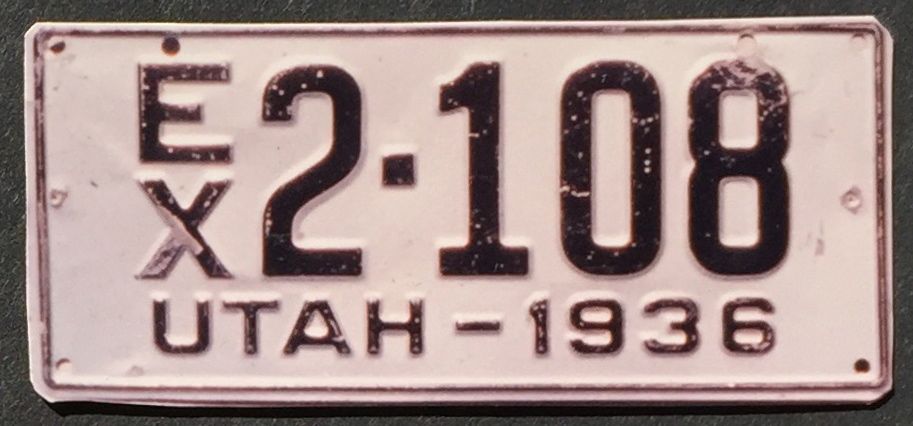 1936 exempt issue. Embossed steel.
1936 exempt issue. Embossed steel.
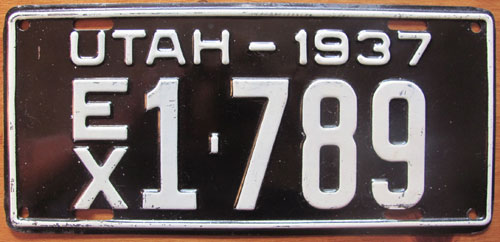 1937 exempt issue. Embossed steel.
1937 exempt issue. Embossed steel.
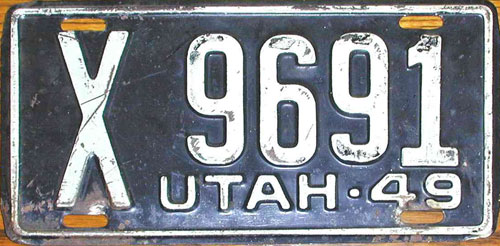 1949 passenger car issue.
1949 passenger car issue. 
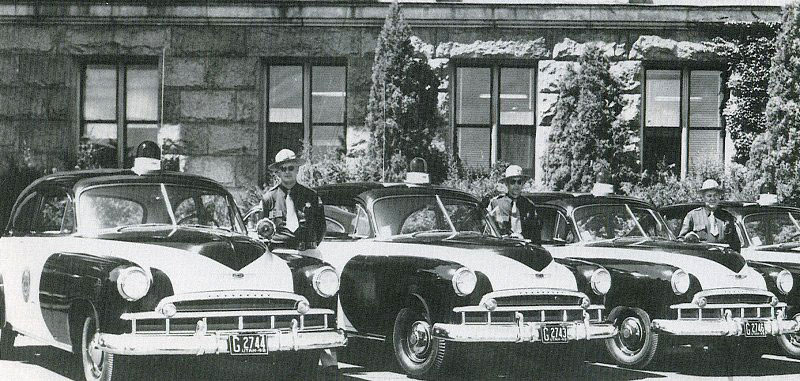
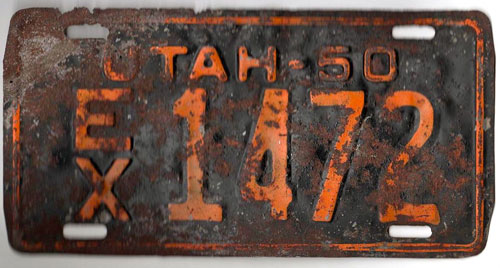 1950 exempt issue. Embossed steel.
1950 exempt issue. Embossed steel.
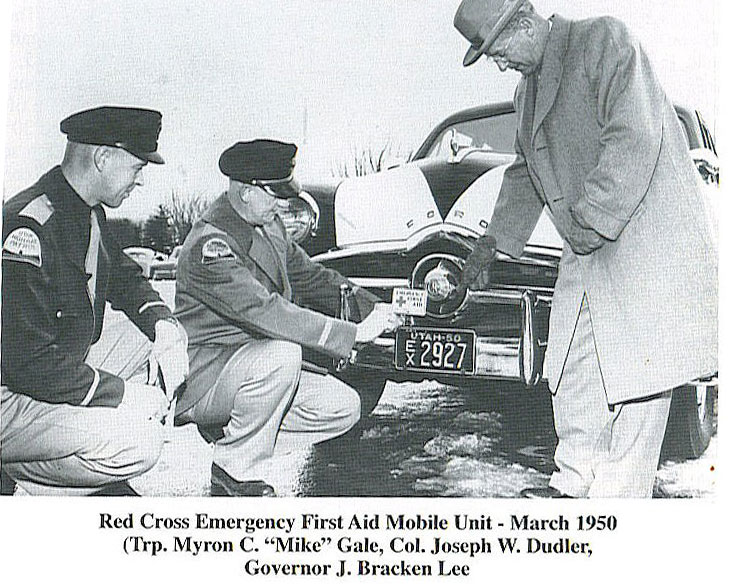
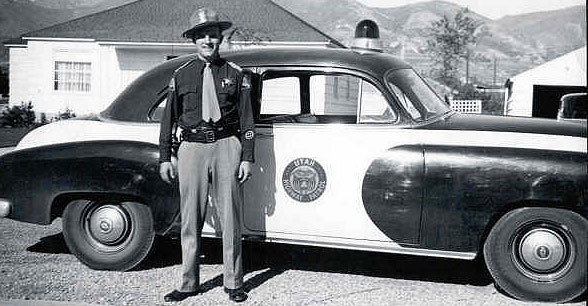
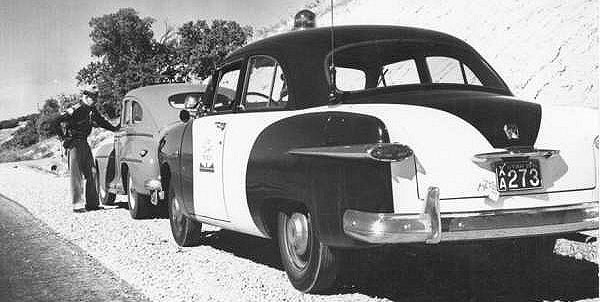
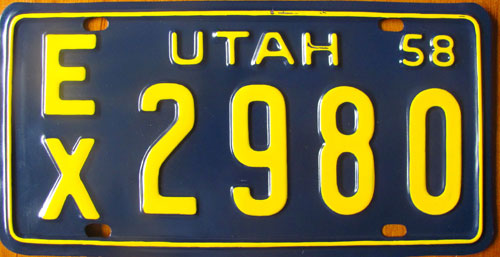 1958 exempt issue. Embossed steel.
1958 exempt issue. Embossed steel.
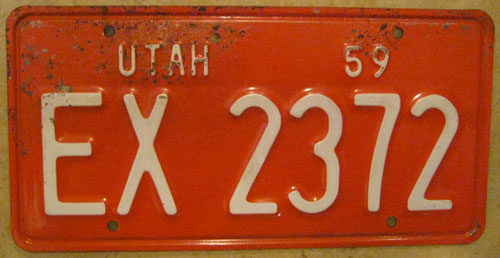 1959 exempt issue. Embossed steel.
1959 exempt issue. Embossed steel.
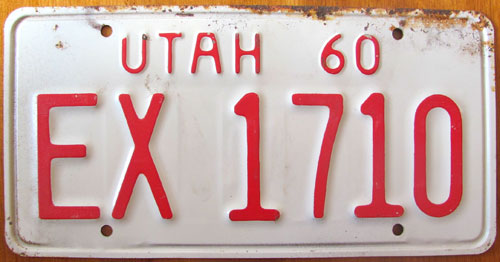 1960 exempt issue. Embossed steel.
1960 exempt issue. Embossed steel.
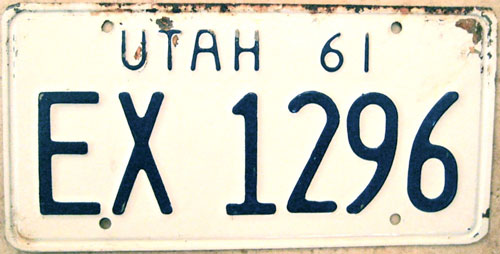 1961 exempt issue. Embossed steel.
1961 exempt issue. Embossed steel.
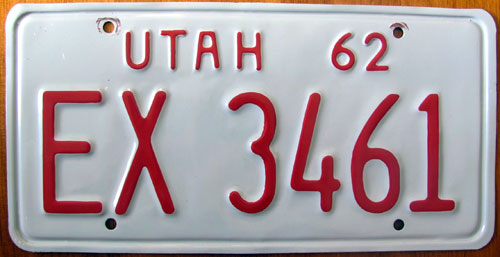 1962 exempt issue. Embossed steel.
1962 exempt issue. Embossed steel.
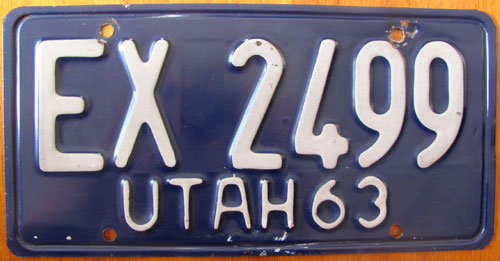 1963 exempt issue. Embossed steel.
1963 exempt issue. Embossed steel.
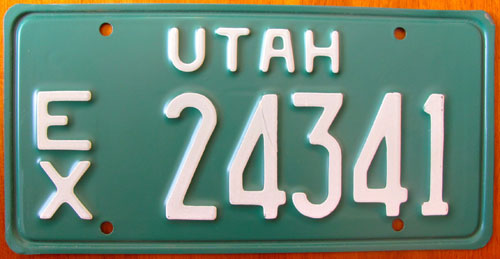 1964-1965 exempt issue.
1964-1965 exempt issue. 
In 1966, there was a decision made to differentiate between regular exempt license plates that were used by county and local police vehicles among others, and state exempt vehicles. The new exempt license plates for the UHP continued with an EX prefix ahead of the five digit number but now with STATE VEHICLE embossed along the bottom of the plate.
Numbers on this base began in the 50000 series. This base plate was manufactured until 1967 when it was decided to use a format where the registration numbers were larger and a reflective paint could be used for the embossed portions of the plate. The 1967 issue had the state name at the top center of the plate and STATE VEHICLE in smaller dies than the 1966 issue. The EX prefix was stacked on the left to permit more room for the registration number.
Both the 1966 and 1967 version of the State Vehicle Exempt license plate were issued until 1969.
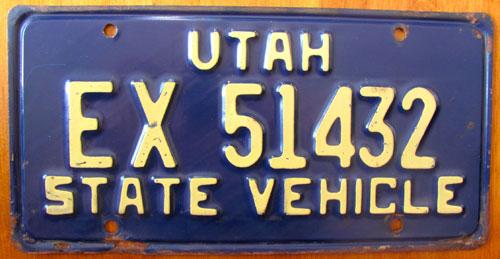 1966-1969 State Vehicle Exempt issue. Embossed steel.
1966-1969 State Vehicle Exempt issue. Embossed steel.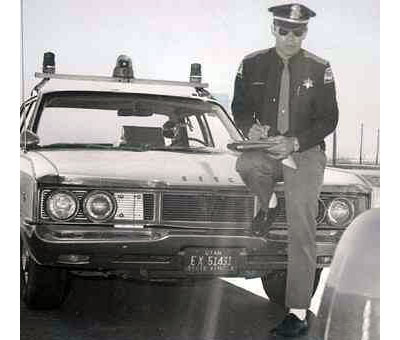
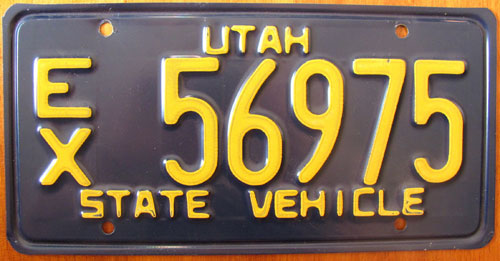 1967-1969 State Vehicle Exempt issue. Embossed steel.
1967-1969 State Vehicle Exempt issue. Embossed steel.
In 1969, the state of Utah unveiled a new State Vehicle Exempt license plate that was used on the marked vehicles of the Utah Highway Patrol.
The plate was made of embossed aluminum and had black characters over a reflective white background and was of the same format as the previous 1967 issue, however with a step border. The state name was embossed in small character font at the top center of the plate. The stacked EX prefix was followed by a space gap of one character width followed by a number of five digits. STATE was embossed over the lower left mounting hole and VEHICLE was embossed over the lower right mounting hole.
Numbers on this base began in the 60000 series. This base plate was used until 1985 where numbering entered the early 70000 series.
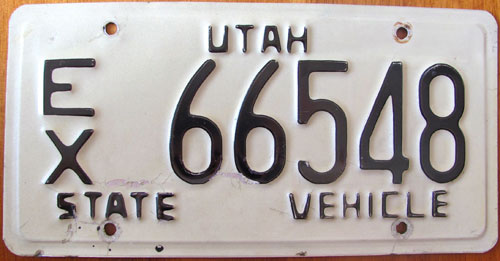 1969-1985 State Vehicle Exempt issue. Embossed aluminum.
1969-1985 State Vehicle Exempt issue. Embossed aluminum.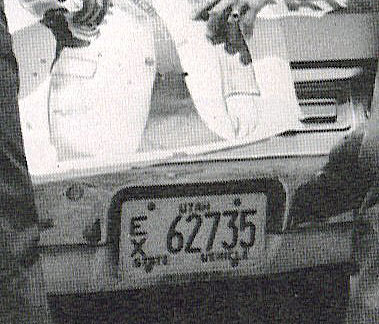
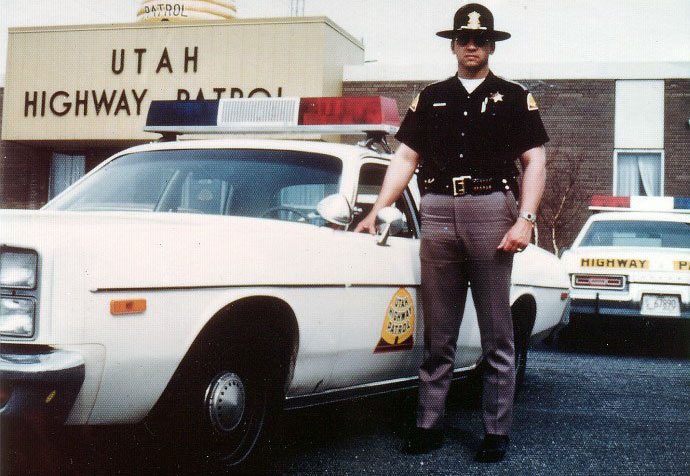
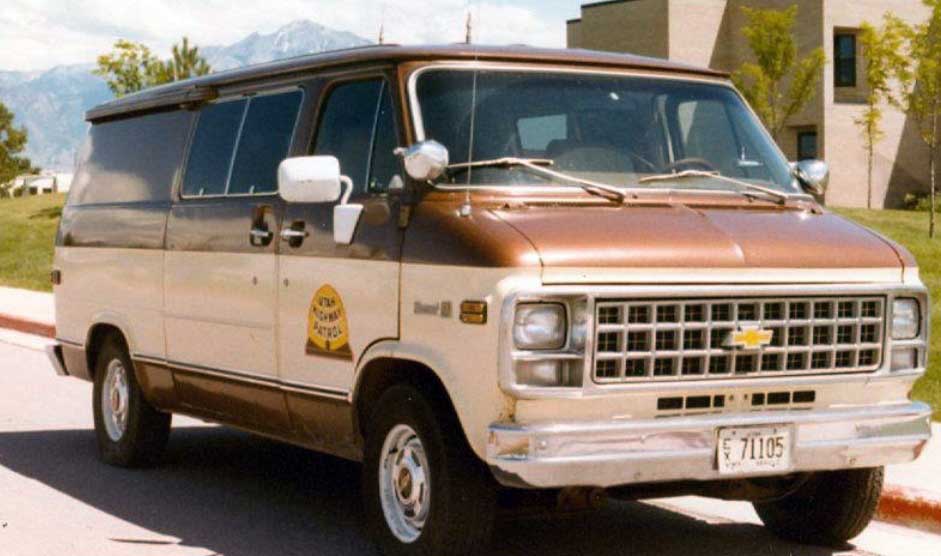 (Courtesy Jim Aitken)
(Courtesy Jim Aitken)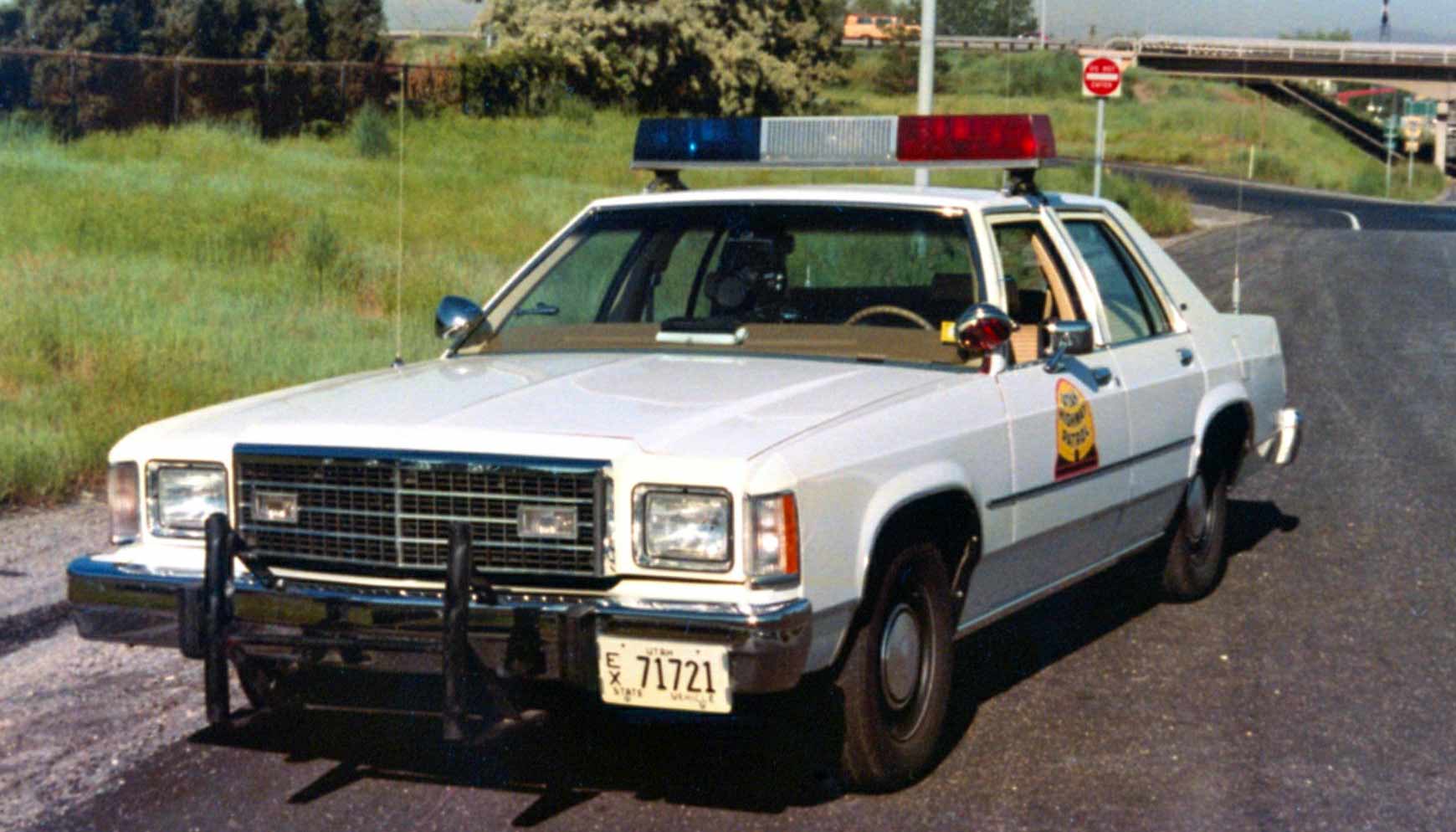
 Circa 1983 standard exempt issue. Embossed aluminum.
Circa 1983 standard exempt issue. Embossed aluminum.
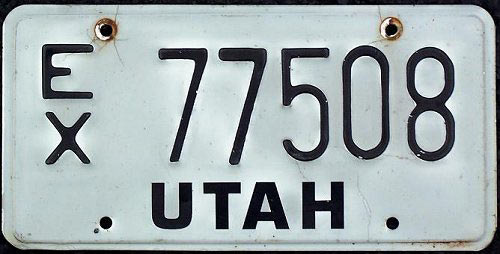 1983-1984 standard exempt issue. Embossed aluminum.
1983-1984 standard exempt issue. Embossed aluminum.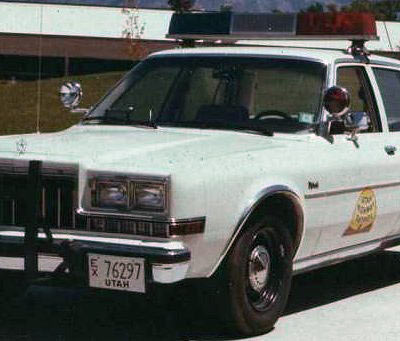
On June 1st 1985, the state prison in Draper had produced and distributed brand new colorful and graphic agency-specific license plates for the Utah Highway Patrol for the first time in their history.
The embossed aluminum license plates had a reflective white background and featured an attractive "canyonland" scene along the entire top span of the license plate. The landscape design was done in three shades of brown over a light blue sky and Utah! silkscreened in red at the top center.
The full-color silkscreened beehive emblem of the UHP occupied a large portion of the lower center of the plate.
Flanking that emblem on the left was the embossed prefix UHP and on the right by the badge number both in dark brown.
The inaugural run of these license plates used the trooper's badge number as the license number, but it is unknown if that practice continues today. The attractive plates were so popular that some plates "went missing" resulting in a policy in February of 1988 to permit retiring UHP troopers to keep the plates from their patrol cars.
Over the years, some of these license plates have been adorned with annual and county validation decals, some bear EXEMPT decals and others bear no decals at all. As of this writing in 2015, this 30 year old design still continues to be issued and run by the UHP on their marked fleet of motor vehicles.
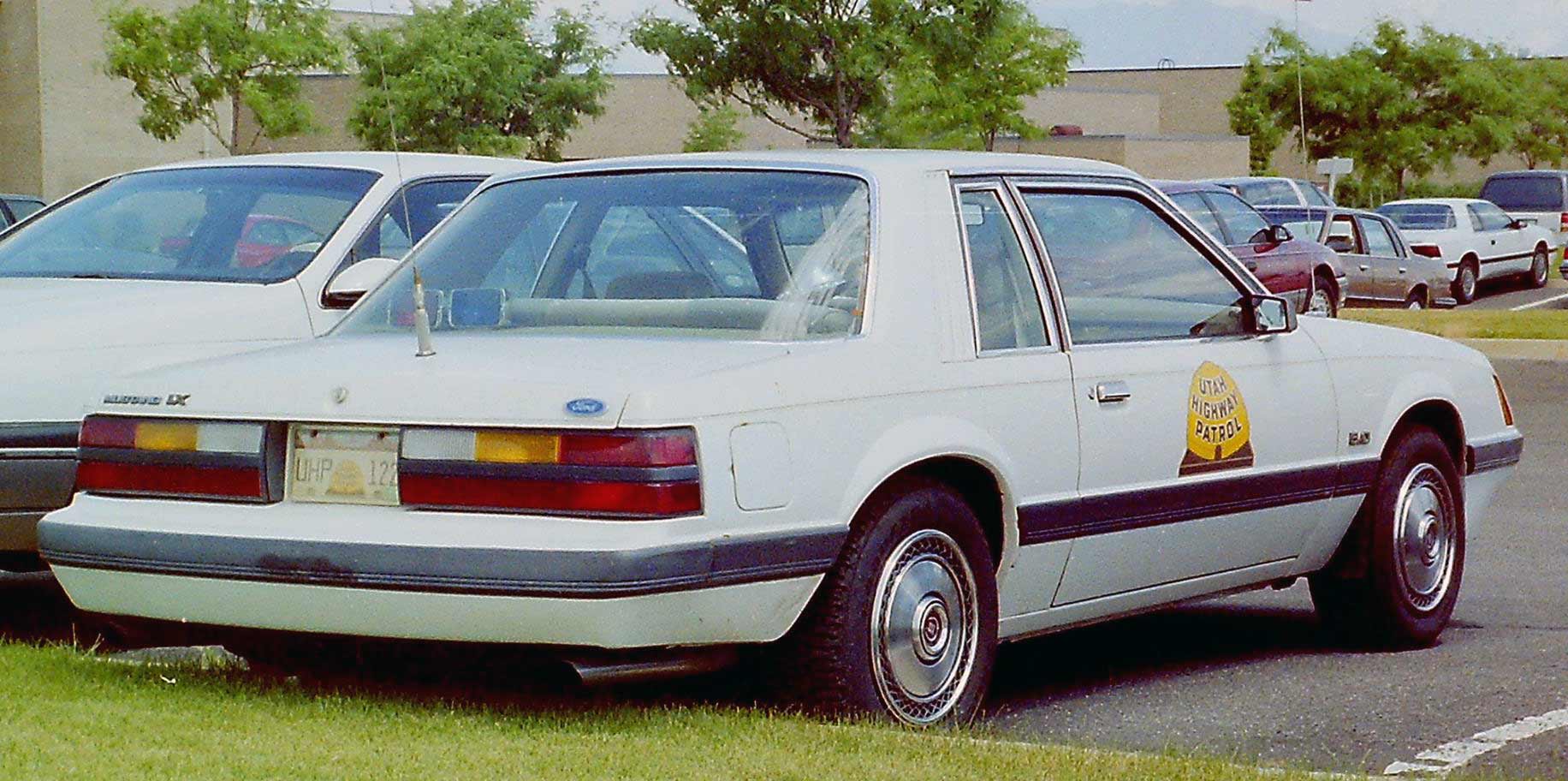 (Courtesy Darryl Lindsay)
(Courtesy Darryl Lindsay)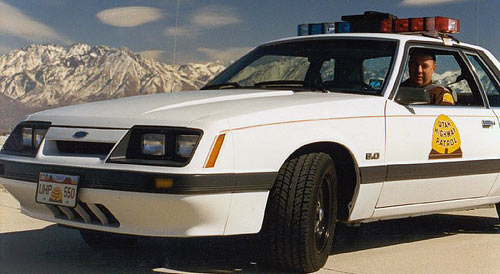
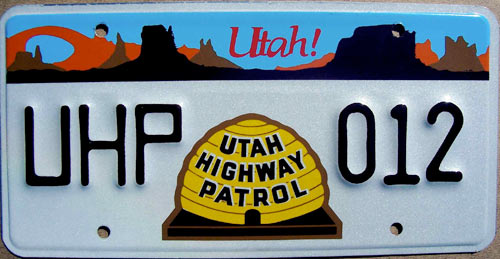 1985-Current issue.
1985-Current issue. 
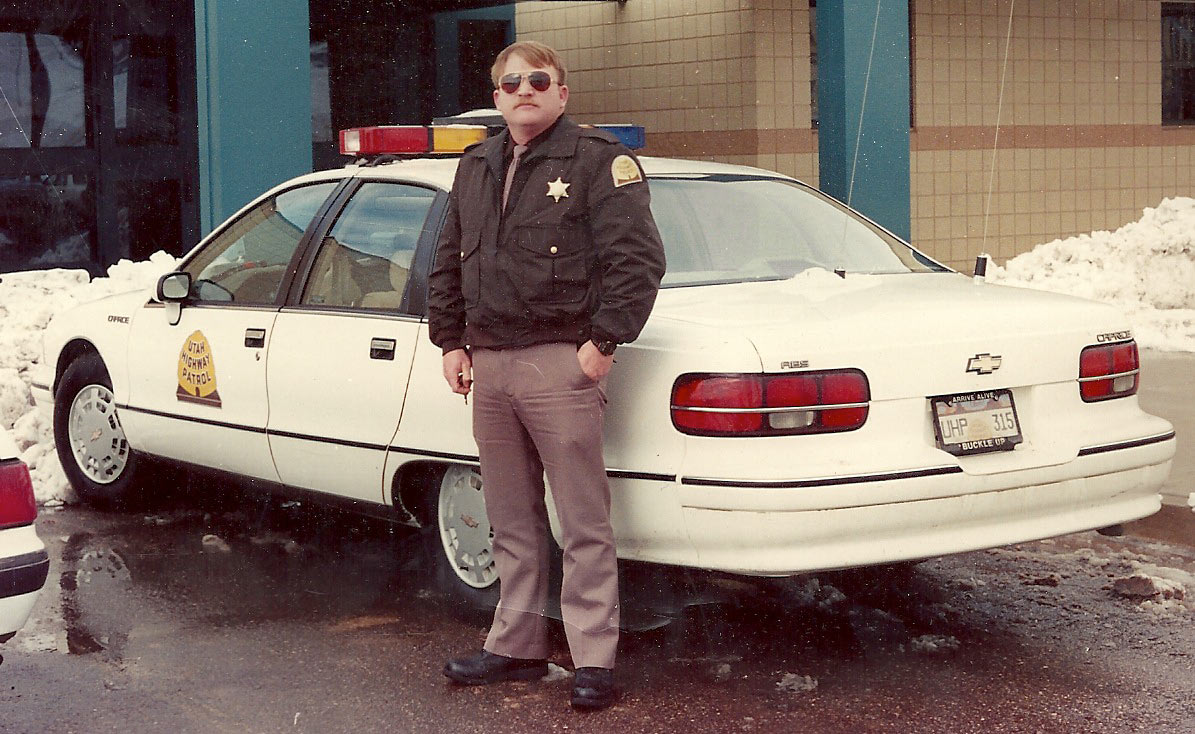
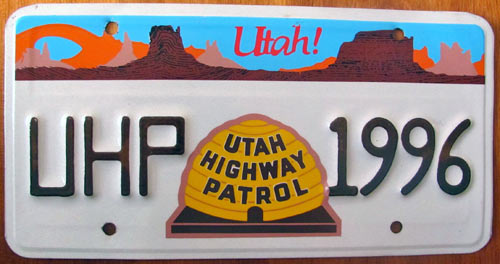 1996 souvenir issue.
1996 souvenir issue. 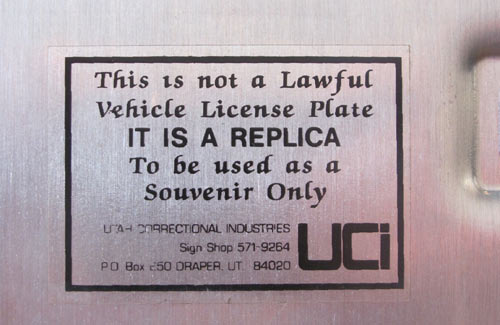 UCI decal on backside of UHP 1996 license plate
UCI decal on backside of UHP 1996 license plate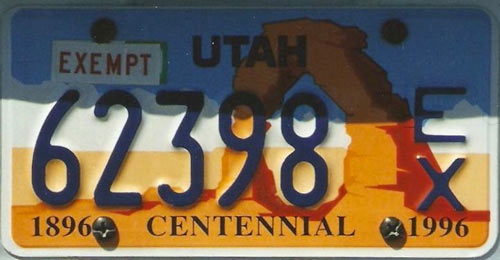 1996-current standard exempt issue. Embossed aluminum
1996-current standard exempt issue. Embossed aluminum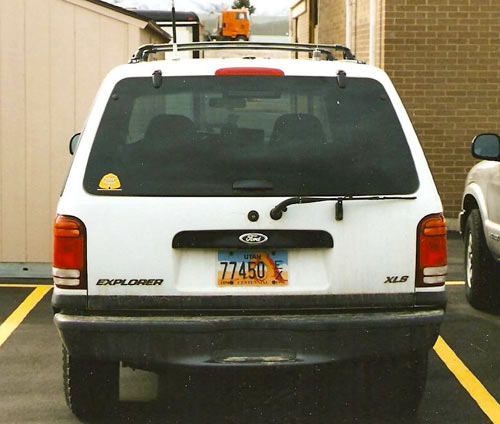
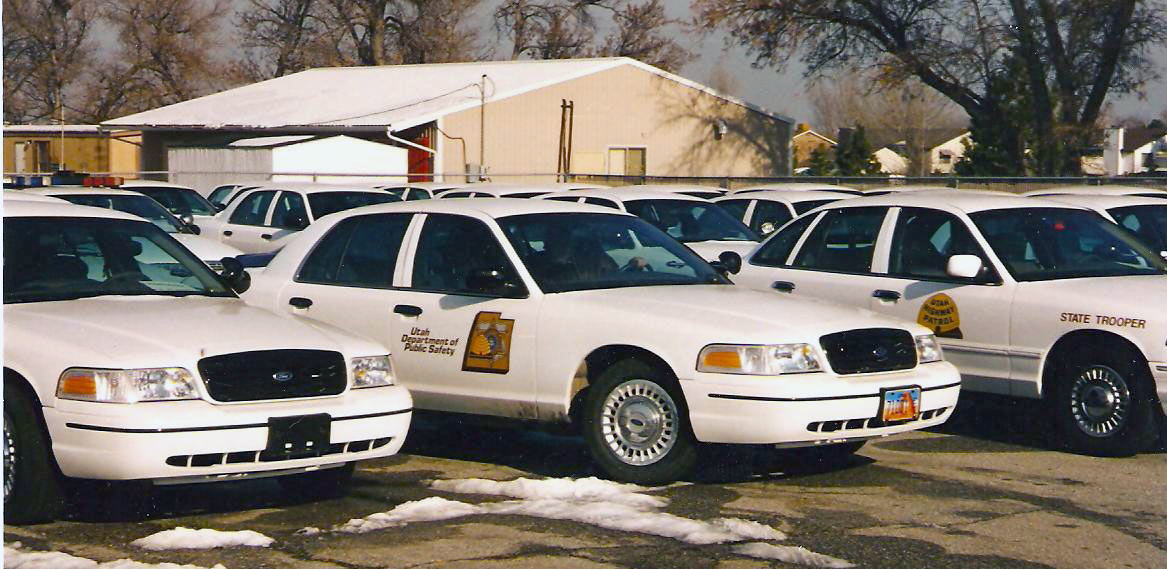
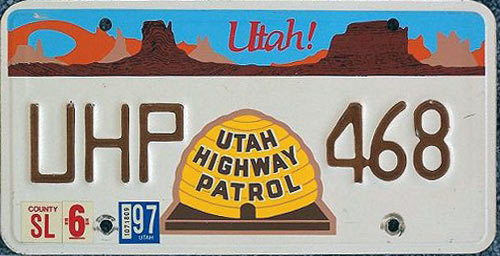 1985-Current issue (1997).
1985-Current issue (1997). 
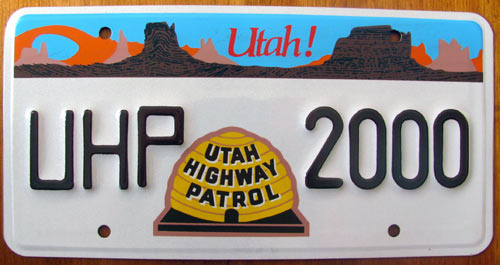 2000 souvenir issue.
2000 souvenir issue. 
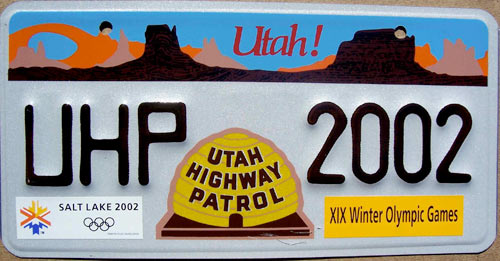 2002 Winter Olympic issue.
2002 Winter Olympic issue. 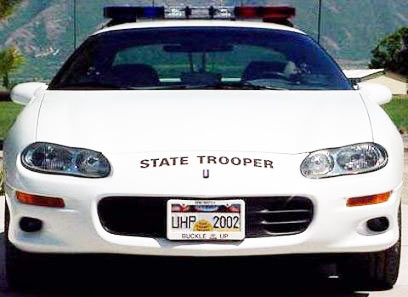 Winter Olympics issue on UHP Camaro
Winter Olympics issue on UHP Camaro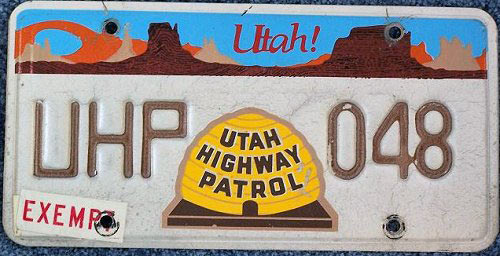 1985-Current issue.
1985-Current issue. 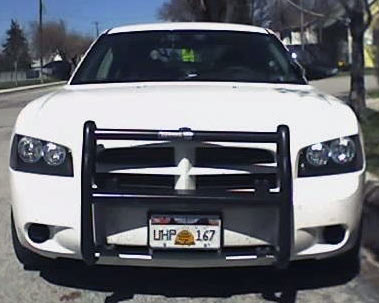
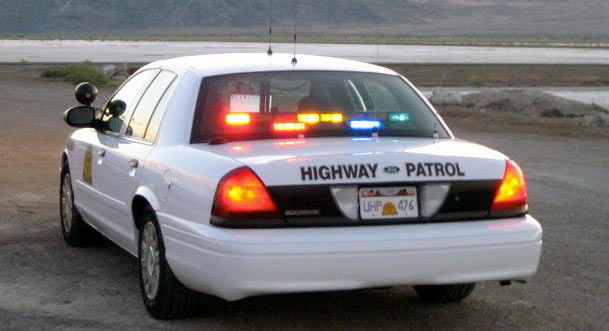
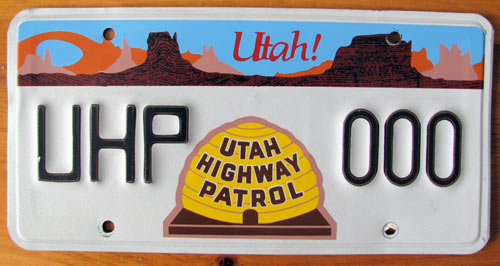 1985-Current SAMPLE issue.
1985-Current SAMPLE issue. 
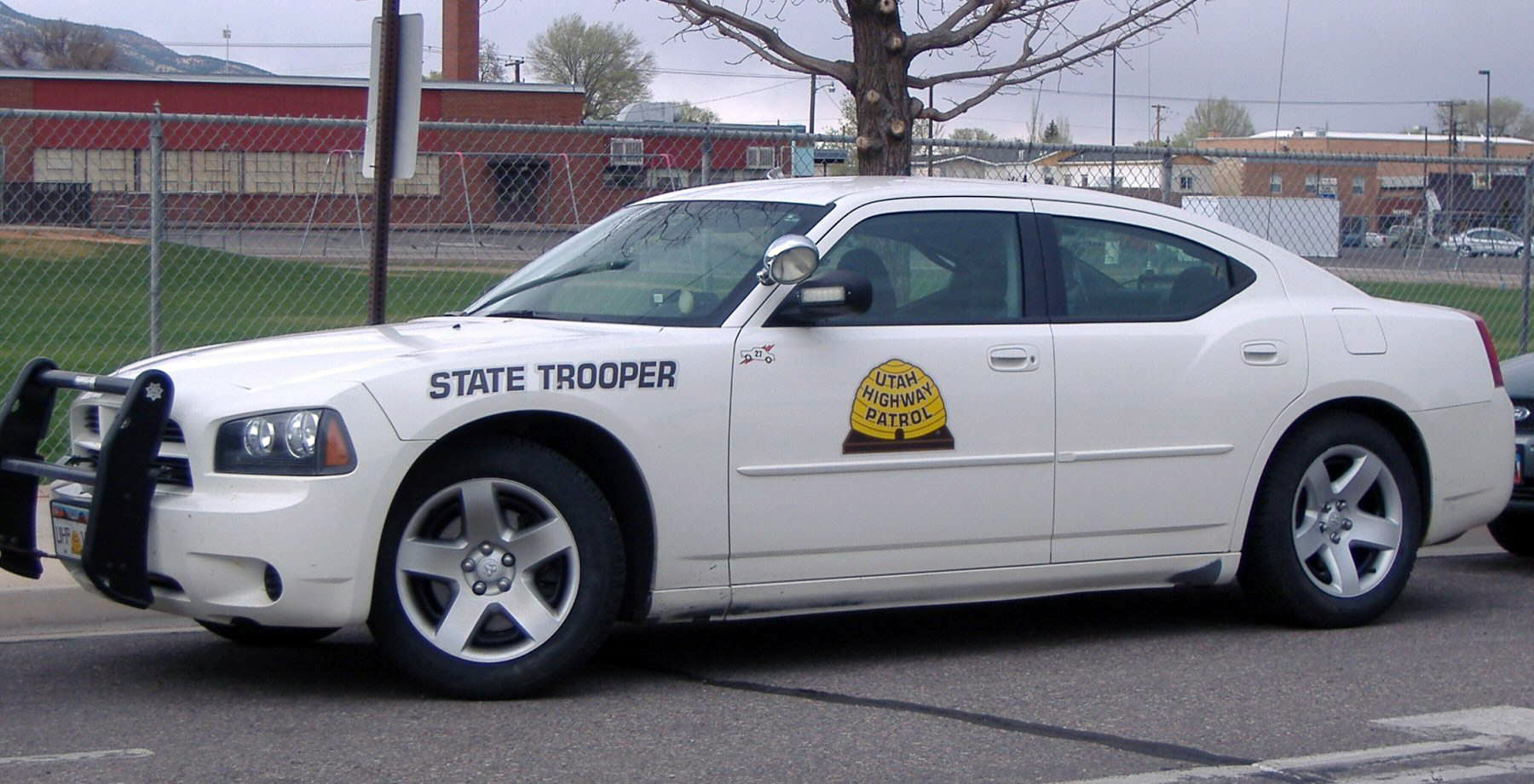
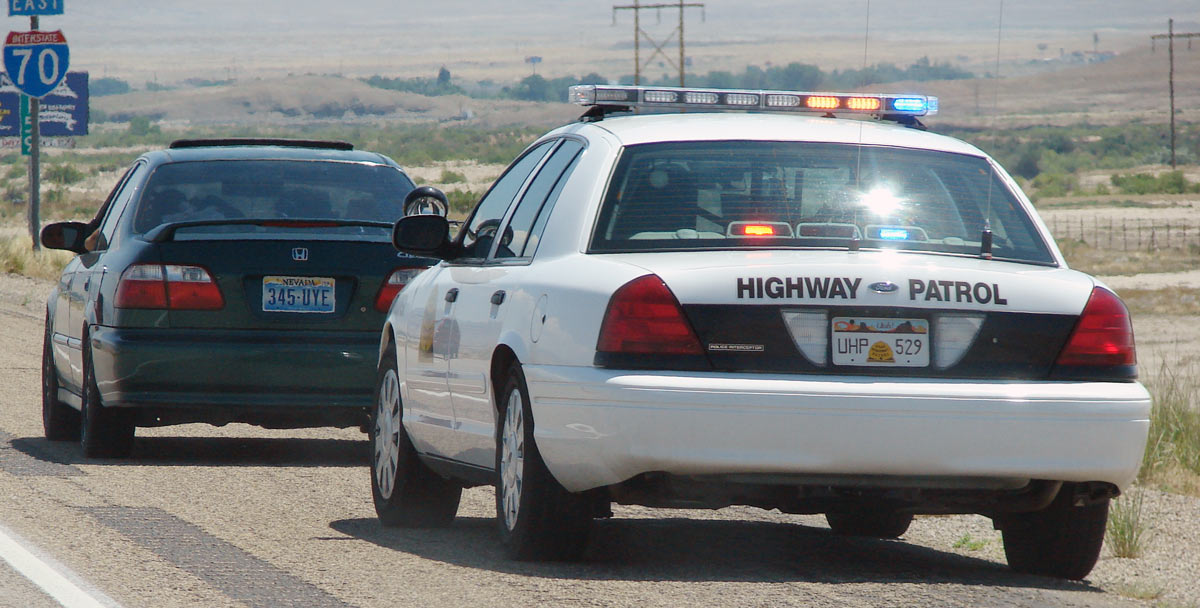
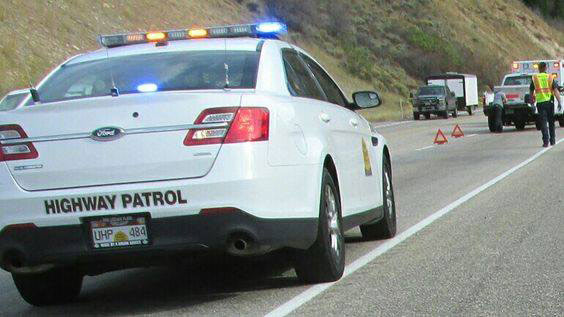
It has been stated but not confirmed, that the Utah Highway Patrol used motorcycles in their fleet from their inception in 1923 until 1945 when they were discontinued.
As there is no record of exempt motorcycle license plate use in Utah until 1964, it is likely that cycles used by the UHP during that time were regular motorcycle license plates.
There is no indication that the UHP utilized any motorcycles in their fleet until they resurged again in 2005.
It was at that time that motorcycle-sized license plates mirroring the design of the UHP "car plates" were introduced. The same "canyonland" scene occupied the top span of the plate, however below that is a full color graphic of the UHP beehive emblem on the left side of the plate. From the center to the right side of the plate is the assignment number silkscreened in brown and beginning with a lead zero.
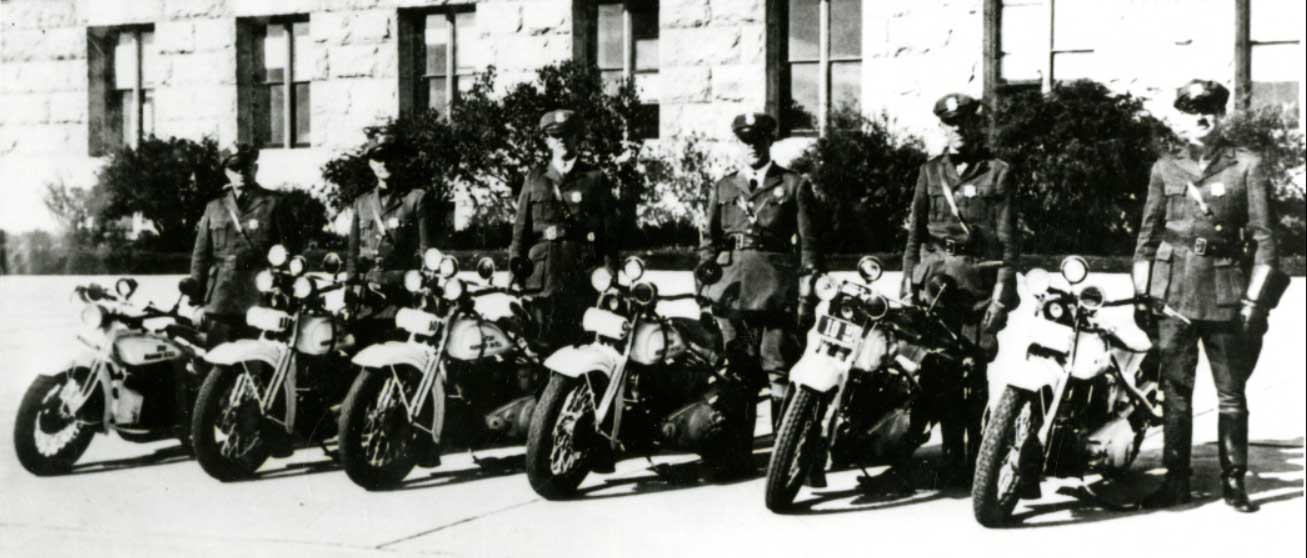 blabla
blabla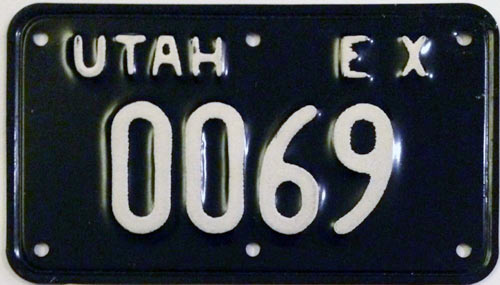 1968-1972 Exempt motorcycle issue. Embossed steel.
1968-1972 Exempt motorcycle issue. Embossed steel.
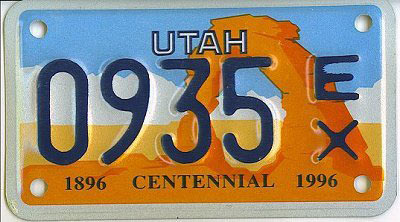 1996-current motorcycle exempt issue. Embossed aluminum.
1996-current motorcycle exempt issue. Embossed aluminum.
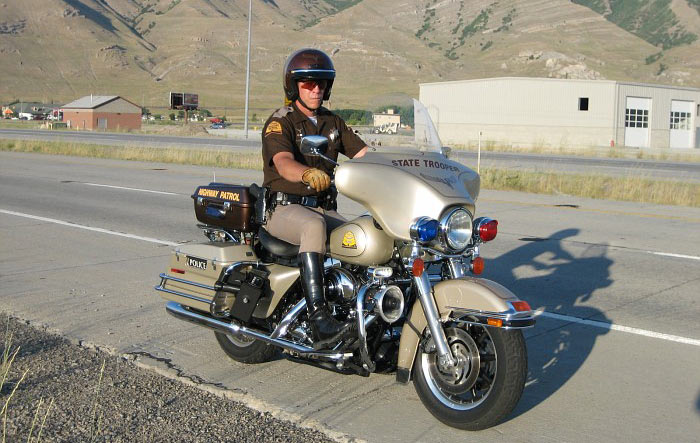
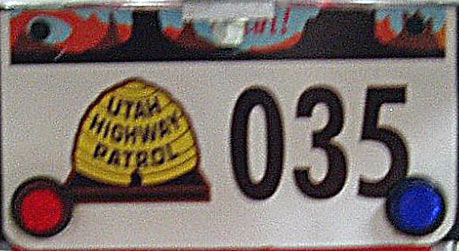 2005-current motorcycle issue. Silkscreened aluminum.
2005-current motorcycle issue. Silkscreened aluminum.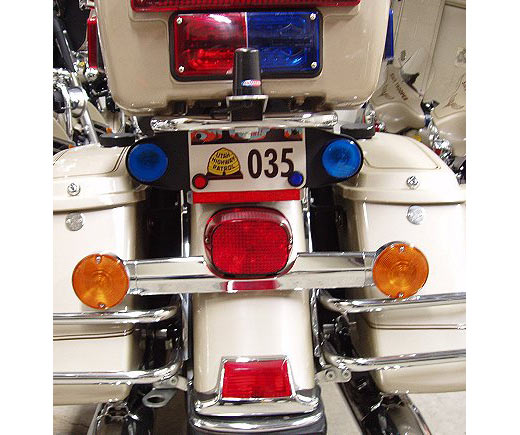
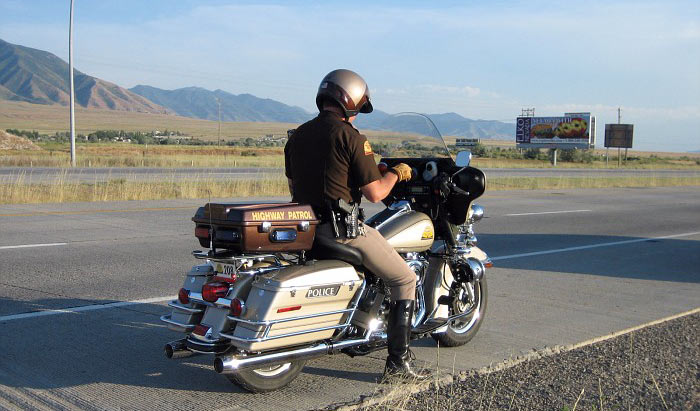
The following are other types issued for UHP.
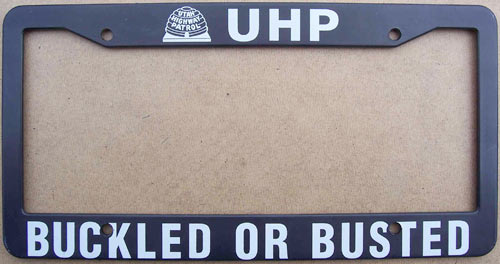 White over black silkscreened plastic license plate frame.
White over black silkscreened plastic license plate frame.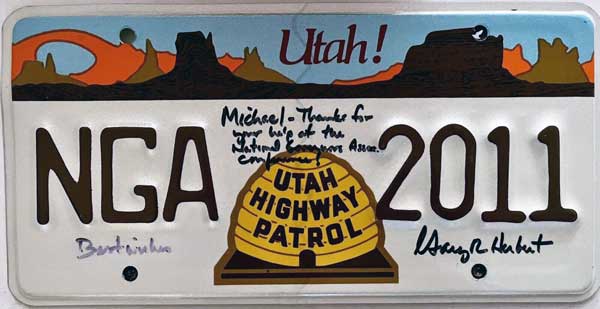 2011 National Governor's Association
2011 National Governor's Association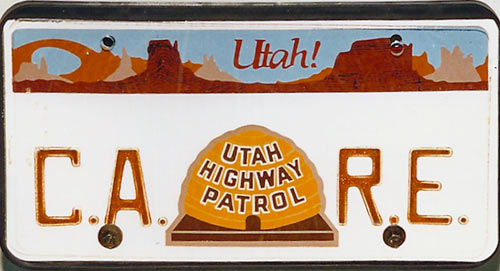 Combined Accident Reduction Effort
Combined Accident Reduction Effort
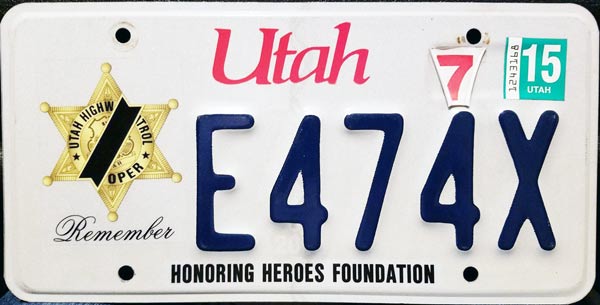 2015 Honoring Heroes Foundation issue.
2015 Honoring Heroes Foundation issue.
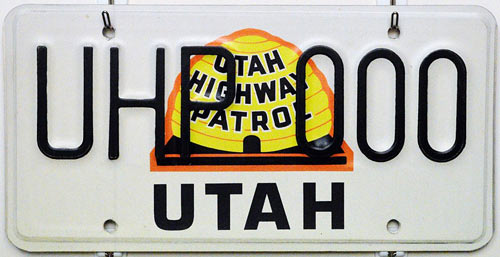 Circa 1984 protoype.
Circa 1984 protoype. 